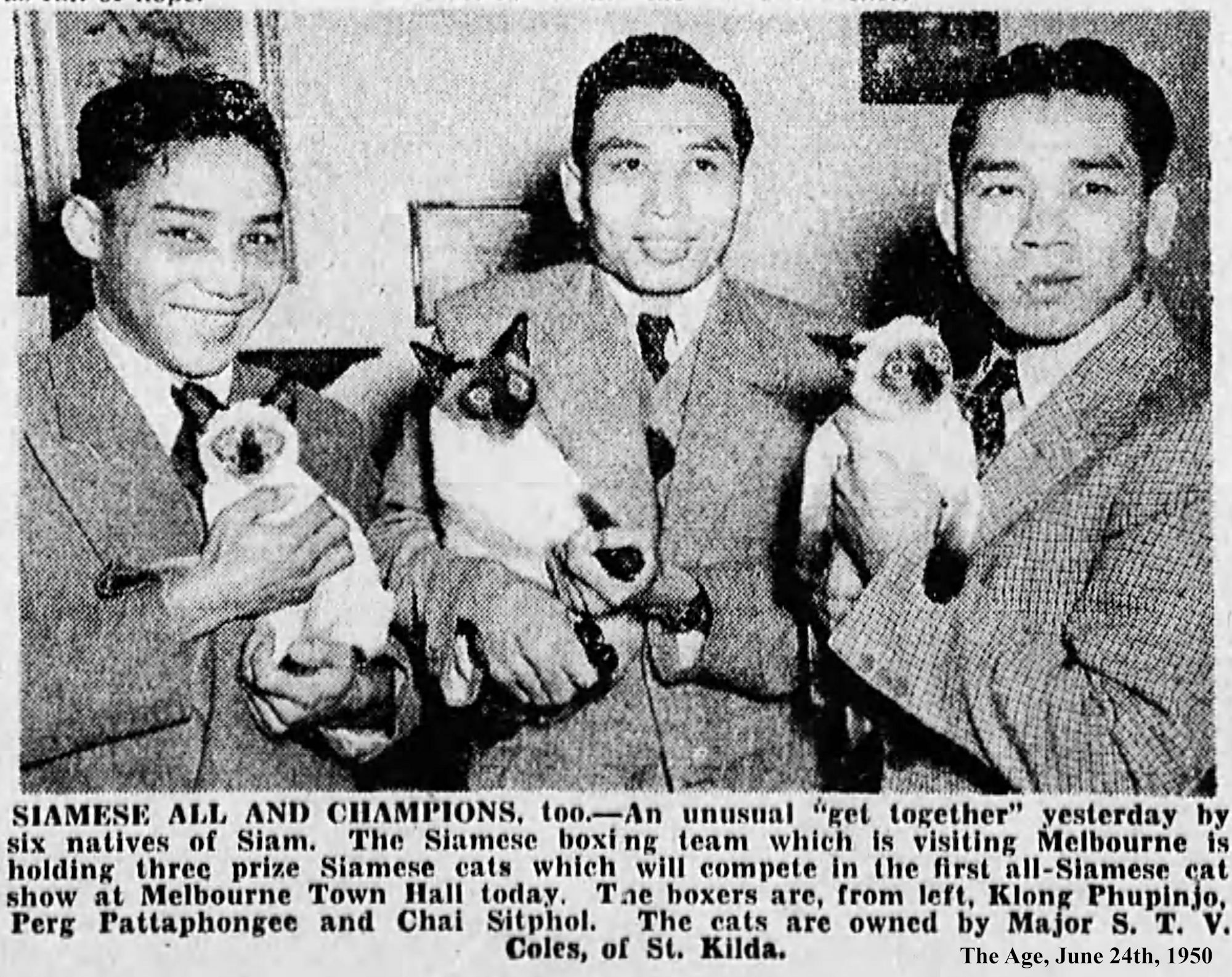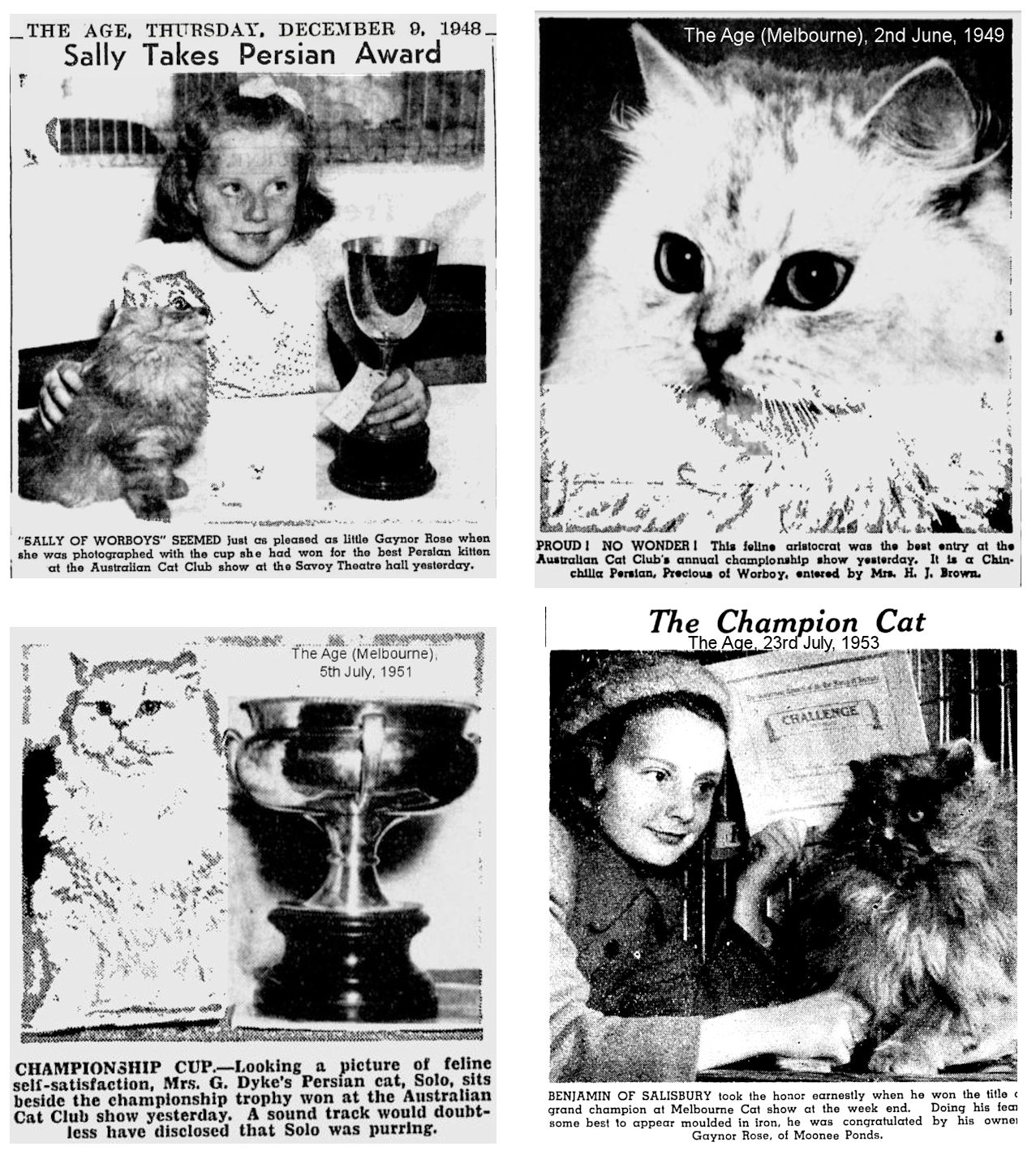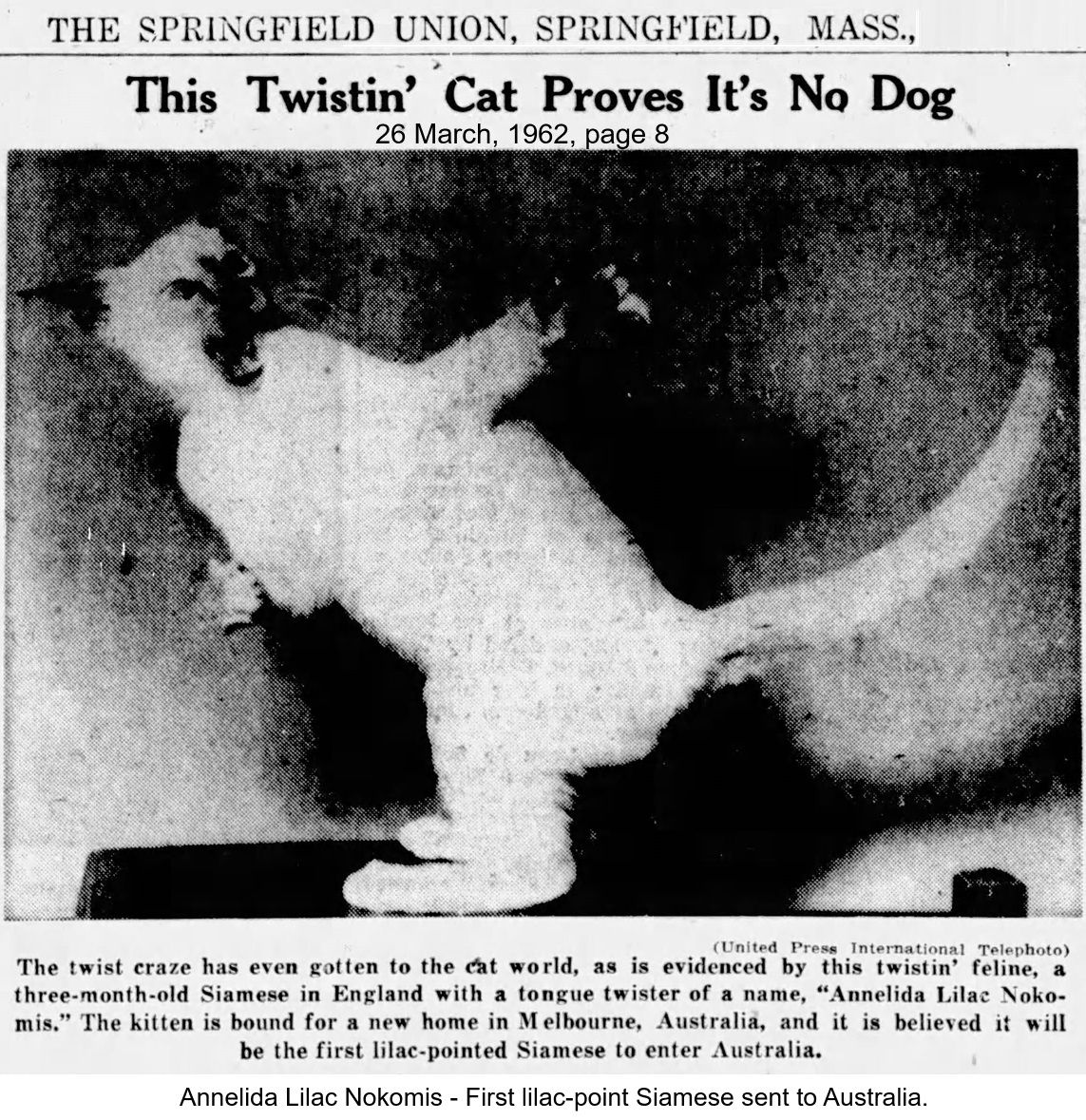
CATS AND THE CAT FANCY IN AUSTRALIA - THE EARLY BREEDS
Australian fanciers, mainly in Victoria and NSW, had owned pedigreed cats before 1900. As in Britain and North America, the pedigree cats were mainly longhairs. The first Siamese cats arrived in 1901 but remained rare until after the Second World War. The early Cat Fancy shows were, therefore, almost all longhair cats with occasional Siamese interlopers.
The original breeds known to be present were much the same as those in Britain and the USA: Persians accounted for most show entries for many years, though Manx, Siamese and Abyssinians were also exhibited. It took more than one attempt to establish some of the breeds and varieties, most likely due to diseases contracted at shows, though we can't rule out contact with venomous Australian wildlife. At one early cat show, 60 cats were exhibited - 58 being pedigree Longhairs and 2 were Siamese.
The catalogue of the Victorian Poultry and Kennel Club Annual Show, 1897, lists a male and female Siamese entered by Mrs Lawson, although the cats failed to turn up for the show. Dr and Mrs Chas Ryan exhibited a pair of Siamese in 1901 and another Siamese in 1904. Mrs A E McLennan advertised imported Royal Siamese in 1902 and exhibited two of these in 1904.
In 1908, "The Australasian Poultry and Kennel World" ran an article Mrs McLennan's "Khio" cattery in Victoria. Mrs McLennan was breeding, among others, seal-point (Royal) Siamese cats. However her breeding lines appear to have died out, perhaps due to infections contracted at shows . A Siamese cat was also featured on newsreel filmed in 1925 at the Deloraine races in Tasmania. The founders of the Royal Siamese in Australia were Wing of Woodrooffe and Woodrooffe Adam (Major S Woodiwiss s prefix he was Hon Sec of the Siamese Cat Club in the UK at the time), imported into New South Wales from Britain in 1925 by Mr and Mrs Lonsdale. These were exhibited at the Australian Cat Club show in Melbourne in June 1925. According to the animal fancier magazine "Our Dogs and Feathers", they caused a furore, much as Siamese cats did when first exhibited to the public in Britain.
Mrs McLennan also exhibited Abyssinians; and owned Khio Sir Peter Teazle and Khio Paul plus Khio Lady Teazle and Khio Virginia. Their origin and parentage isn't stated in show catalogues. The Khio Abyssinians also seem to have been lost, so perhaps the whole cattery was ravaged by "show fever" because modern Australian Abyssinian lines trace back to British imports in 1959 and not to 1890s.
The Victorian Poultry and Kennel Club Show catalogues of 1889 had a class for Royal Siamese, while that of 1896 had classes for Siamese and for Abyssinians. In 1895, there was a class for the Angora cat. Although these often lacked entries, it may attest to the breeds being present in the early Australian cat fancy. However, Show catalogues indicate that the Manx cat was relatively numerous in the mid 1890s. However, a word of caution - early cat shows around the world offered classes for breeds that might turn up, as the ever-empty class for the Chinese Lop-Eared cat at early European cat shows demonstrates.
According to the 1908 article, Mrs McLennan also bred Blue Persians, Orange Persian, (shaded) Silver and Chinchilla Persians and Silver Tabbies. Mrs McLennan's Persians were mainly of British origin, imported in 1900 and 1901 from Mrs Foote (UK). Persians were the most numerous fancy breed during the 1880s and 1890s and were imported from Britain, France, the USA and South Africa. In 1895 Charles Lynott exhibited an imported Chinchilla female, an imported "Brown" Persian female and a Persian male (unknown colour) at the Victorian Poultry and Kennel Club Show. In 1908, Mrs DM Matthews imported a breeding pair of blue-eyed White Persians, Wild White Rose and Blue-Eyed Robin, specially selected for her by Frances Simpson in Britain. These appear to have upset local Australian breeders resulting in the cats being shown under the wrong name and not being awarded prizes as a result. It was suggested in correspondence printed in Australasian Poultry and Kennel World that the show secretary (who was a competing exhibitor!), Mrs Harriet McLennan, had resorted to underhand tactics in this matter. Mrs McLennan sued both Mrs Matthews and the magazine for libel and though she won, technically, she ceased being the Hon Sec of the ALKC and appears to have stopped exhibiting cats.
After the Second World War, Siamese cats became increasingly popular. Before 1950 the only Siamese in Australia were Seal Points. Breeders imported new blood from some of the finest English lines and these showed that the Australian-bred cats lagged in terms of conformation and quality (probably due to inbreeding). More Seal Points and Blue Points arrived from England, and some of the Seal Points produced Chocolate Point offspring (not until 1963 did Lilac Points appear, and they were imported). The Siamese Cat Club of Australia was founded at the beginning of 1950 and held its first show in June 1950 in Melbourne Town Hall. It attracted over 3,000 visitors.
The sophisticated and exciting Siamese quickly became very popular with the post-war public to the detriment of the old-fashioned longhairs. Even the importation of some excellent longhairs could not stop their decline. There were no attempts to develop new colours or patterns in longhairs so they may have been viewed as boring until their revival during the 1970s.
The 1950s Siamese imports were followed by the first pair of Russian Blues, but these had no offspring and the breed attracted little interest. Abyssinian cats arrived in 1959 when two were imported from New Zealand and one from the UK (WWII had almost wiped out the Abyssinian cat population in the UK and the population there was rebuilt using American cats). The Abyssinian Cat Club of Australasia was formed in 1966.

"PEDIGREE TWICE AS LONG AS HER TAIL - The Age, Melbourne, Victoria, Australia, 26th June, 1950
Obviously aware of her aristocratic pedigree, which dates back 20 generations and is more than twice the length of her tail a very long one, which is a most important sign of good breeding Circe of Sedgemore is one of the proudest Siamese cats in Melbourne today. Owned by Mrs. D.J. Chandler, she was judged champion at the Siamese Cat Club's first annual show in the Lower Melbourne Town Hall on Saturday. The show was officially opened by the Governor's daughter, Miss Jeanette Brooks, who was presented with a Siamese kitten, Baghead of Wyeeboo, who has already been given a pet name, Jeremy, by his new owner. Regret was expressed by the club secretary (Mr. D.J.C. Chandler) on behalf of the Lord Mayor s Fund, which benefited from the show, that many people were unable to gain admittance. Public interest had been far greater than anticipated.
What could be more appropriate in these days of streamlined two-tone cars than a streamlined two-toned cat! That describes the Siamese aptly. Streamlined because his body is long and slim but firm, and two-toned because the close glossy cream fur of his coat adds a contrast to hisseal brown face, pointed ears, paws and long tail. In the language of Siam the cream of the cat’s fur is called "Sriswart," which means the color of love and affection. The Siamese cat is regarded as a better companion than the ordinary domestic cat (it has the loyalty of the dog and becomes a “one man” cat), is a better hunter, hunting for rabbits and birds, not just for the sake of killing, but to bring back game to its master, and is more agile in both running and climbing.
Contrary to common belief, owners of Siamese cats do not pamper them and make them and indoor pet only. Mrs. J. Hine, whose Siamese cat, Nugat, produced a litter of 10 kittens - claimed to be a world record - allows her cats to run almost wild on her farm at Lara. Too much petting of the animals tends to make them weak and they become hard to rear. A quaint feature of some Siamese cats is the small crinkle at the end of the tail. This trend carried many legends which were related by Miss Voranuj Pramoj, who came from Siam three years ago to attend Kindergarten Training College in Melbourne, and was present at the show.
One of the tales, which also accounts for the squint which was once another common characteristic among Siamese cats, but which is not almost out-bred, goes like this: Hundreds of years ago two priests living with their Siamese cat in a temple had a great responsibility. They had the care of a sacred goblet. One day the older priest died and it was necessary for the younger one to leave the temple to find someone to take his place. The cat was left to guard the sacred goblet and to be quite sure it was safe she twisted the end of her tail firmly around it. As she was waiting for the priest s return she gave birth to a litter of kittens and because she was watching the door with one eye and the goblet with the other they were born with squint eyes and small crinkles at the ends of their tails.
Nowadays, however, judges eliminate points from the cat with the crinkly tail and so catteries are trying to breed out this fault.
Siam can boast of several other types of cats which are found only in that country. There are black cats with blue eyes, black and white cats with blue or sometimes ruby-red eyes and cats with coats striped in fawn, brown and grey-green. These are domestic cats and, like the "tabby" cat in Australia, are usually given to their owners, whereas the Siamese cat in Siam can only be bought by the very wealthy. Nearly everyone in Siam owns a cat and because these people love cats, anyone killing one invites the penalty of bein ostracised.
The most expensive exhibit in the whole show on Saturday was Mrs H. Chase s imported Russian Blue. Mouchemokey, who was judged champion for his class. Although a first cousin to the Siamese cat, the Russian Blue has an entirely different nature. He is extremely snobbish towards strangers, takes a long time to really become acquainted with his master and then is not particularly loyal, and is very fastidious about food. One-year-old Mouchemokey has already acquired the majestic air of looking down his nose at strangers and when bored of their company seeks refuge in higher places. All Mouchemokey s movements could be compared with those of a leopard. Although he is a small cat with a long lean body and limbs, as he moves strong muscles ripple under his sleek dark blue-grey coat. His pretty face is small and kitten like, swamped with two huge almond shaped eyes, the colour of the sea when it is calm."

Because Australia is a continent its climate varies from sub-tropical in the north to cooler in the south. Judges had to be aware that this affected cats coats: Siamese from the north tended to be lighter in colour than those in temperate New South Wales, South Australia and Western Australia, while in cooler Victoria and Tasmania they tended to be darker with thicker fur; similarly longhairs in the south had more imposing coats than those in the north.

A HOME-GROWN AUSTRALIAN BREED?
Australian fanciers were importing those breeds known to the organised cat fancy in other English-speaking countries, but what about developing their own breeds? (The USA recognised the Maine Coon and Maltese). In fact some curious home-grown Australian cats were exported to the USA in the 1890s, but don't seem to have gained recognition in Australia. The Australian breed was described by Robert Kent James in 1898 and in 1900 by Helen Winslow ("Concerning Cats"). Winslow wrote that Dr and Mrs Hammond in Connecticut specialised in rare Australian cats and had won numerous prizes with them in the USA. Some of his Australian cats were US$500 each; they were also delicate and had small litters. Other writers mentioned their large ears and arched foreheads and that they were sleek cats, with short, glossy fur and small, narrow heads. The Hammonds believed that the breed was derived from Siamese cats imported from Siam to Australia (if so, Siamese must have reached Australia prior to 1898). In March 1902, a description of the "Australian cat" in the magazine "Our Cats" referred to a little spotted cat with a triple-kinked tail and very curious hindquarters: the curve from the heels going deep into the fleshy part of the hind-legs, and suggesting a long, leaping gait (the kinked tail sounds akin to the Japanese Bobtail, a breed not known to Western fanciers at that time). These descriptions were repeated in a number of publications in 1902 and 1903, including Frances Simpson's "The Book of the Cat". The Australian cat was recognized by the CFA in the USA in 1910 in white, tabby-and-white, tortie-and-white, tabby and "seal-brown", but by 1925 had gone into rapid decline due to a lack of breeding males, probably compounded by inbreeding. The last mention of the Australian breed seems to be 1927. It was possibly an early representative of the Oriental Shorthair group.
|
|
|
|
Australian Cat (1900) (Tricksey, male) |
Australian Cat (1902) |
|
|
|
|
Australian Cat (circa 1920) (short-legged female) |
Australian Male "Amee" |
